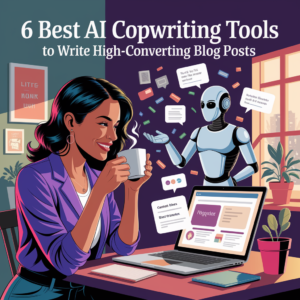How to Attract High-Paying Clients as a Novice Copywriter: Copywriting for Beginners
Copywriting for beginners is a powerful tool that can help businesses attract, engage, and convert their target audience.
Whether you’re creating website content, social media posts, or marketing emails, the ability to write persuasively is essential for success.
If you’re new to the world of copywriting, mastering this skill may seem daunting at first.
However, with the right techniques and practice, anyone can become a proficient copywriter, even if you’re just starting out with copywriting for beginners.
In this article, we’ll explore the key principles of persuasive writing and provide practical tips for beginners looking to improve their copywriting skills.
By the end of this guide, you’ll have a solid foundation in copywriting and be well on your way to crafting compelling content that resonates with your audience.
So, let’s dive in and discover how you can become a master of persuasive writing, even if you’re starting from scratch with copywriting for beginners.
Get ready to unleash your creativity and take your writing to the next level with these essential copywriting techniques for beginners.
We strongly recommend that you check out our guide on how to take advantage of AI in today’s passive income economy.
Table of Contents
Understanding Your Target Audience
One of the most critical aspects of effective copywriting is understanding your target audience.
Before you start writing, take the time to research and analyze your ideal reader or customer.
Consider their demographics, interests, pain points, and goals.
By gaining a deep understanding of your audience, you can tailor your message to resonate with them on a personal level.
Conduct surveys, analyze customer data, and engage in social media listening to gather valuable insights.
The more you know about your target audience, the better equipped you’ll be to craft persuasive copy that speaks directly to their needs and desires.
Remember, effective copywriting is not about pushing your own agenda, but rather about addressing the unique challenges and aspirations of your readers.
Creating Buyer Personas
To further enhance your understanding of your target audience, consider creating buyer personas.
A buyer persona is a fictional representation of your ideal customer based on real data and research.
It includes details such as their age, occupation, income level, hobbies, and purchasing behaviors.
By developing buyer personas, you can visualize your target audience as real individuals and create copy that appeals to their specific characteristics.
Give each persona a name, a backstory, and a set of goals and challenges they face.
Use these personas as a guide when writing your copy, ensuring that your message is tailored to their unique perspective.
Copywriting for beginners often involves learning how to create and utilize buyer personas effectively.
By doing so, you’ll be able to craft copy that resonates with your audience on a deeper level.
Crafting Compelling Headlines
In the world of copywriting, headlines are your first opportunity to capture your reader’s attention and entice them to continue reading.
A compelling headline can make the difference between a piece of copy that gets ignored and one that generates engagement and conversions.
When writing headlines, focus on creating a sense of urgency, intrigue, or curiosity.
Use power words that evoke emotion and make a strong impact.
Consider using numbers, questions, or bold statements to draw the reader in.
Your headline should clearly communicate the main benefit or promise of your copy, giving readers a reason to invest their time and attention.
Test different headline variations to see which ones generate the highest click-through rates and engagement.
Copywriting for beginners often involves experimenting with different headline formulas and styles to find what works best for your audience.
The Four U’s of Headline Writing
When crafting headlines, keep in mind the four U’s of headline writing: unique, ultra-specific, useful, and urgent.
A unique headline stands out from the competition and offers a fresh perspective or approach.
An ultra-specific headline clearly communicates the key benefit or topic of your copy, leaving no room for ambiguity.
A useful headline promises value and relevance to the reader, addressing their specific needs or interests.
Finally, an urgent headline creates a sense of immediacy and encourages the reader to take action.
By incorporating these four elements into your headlines, you’ll be able to grab your audience’s attention and compel them to read further.
Remember, a strong headline is the gateway to your copy, so invest time and effort into crafting ones that truly shine.
Copywriting for beginners is all about mastering the art of headline writing and understanding how to apply the four U’s effectively.
Writing Persuasive Body Copy
Once you’ve captured your reader’s attention with a compelling headline, it’s time to deliver on that promise with persuasive body copy.
The body of your copy is where you have the opportunity to expand on your main points, provide supporting evidence, and guide the reader towards a desired action.
Start by clearly stating the main benefit or problem your copy addresses.
Use simple, concise language that is easy to understand and follow.
Break up your copy into short paragraphs and use subheadings to improve readability and scanability.
Incorporate storytelling techniques to engage the reader and create an emotional connection.
Use examples, analogies, and case studies to illustrate your points and make your copy more relatable.
Address potential objections or concerns the reader may have, and provide reassurance and solutions.
As you write, keep your target audience in mind and focus on the benefits they will receive from your product, service, or ideas.
Copywriting for beginners involves learning how to structure and present information in a way that is both persuasive and easy to digest.
Mastering the Art of Persuasion
To truly master the art of persuasive writing, it’s essential to understand the key principles of persuasion.
One of the most effective techniques is social proof, which involves using testimonials, reviews, or statistics to demonstrate the credibility and effectiveness of your offering.
Another powerful technique is scarcity, which creates a sense of urgency by highlighting the limited availability or time-sensitive nature of your offer.
Reciprocity is another persuasive principle, where you provide value upfront, such as a free resource or helpful information, to build trust and encourage the reader to reciprocate by taking a desired action.
Consistency is also important in persuasive writing, as people tend to align their actions with their previous commitments or beliefs.
By incorporating these persuasive techniques into your copy, you can influence your reader’s decision-making process and guide them towards a desired outcome.
Copywriting for beginners is about understanding and applying these persuasive principles effectively to create copy that motivates and inspires action.
Crafting Strong Calls-to-Action (CTAs)
No piece of copy is complete without a clear and compelling call-to-action (CTA).
A CTA is a statement or button that prompts the reader to take a specific action, such as making a purchase, signing up for a newsletter, or downloading a resource.
When crafting CTAs, use action-oriented language that creates a sense of urgency and motivates the reader to act.
Be specific about the action you want the reader to take and the benefits they will receive by doing so.
Place your CTAs in prominent locations, such as at the end of your copy or in a highly visible button.
Test different CTA variations to see which ones generate the highest conversion rates.
Remember, a strong CTA is the final push that encourages your reader to take the desired action and engage with your brand.
Copywriting for beginners often involves learning how to create compelling CTAs that drive results and maximize the impact of your persuasive writing.
Editing and Refining Your Copy
Once you’ve written your initial draft, it’s crucial to take the time to edit and refine your copy.
Editing involves reviewing your copy for clarity, coherence, and persuasiveness.
Look for opportunities to streamline your message, eliminate unnecessary words, and improve the overall flow of your writing.
Check for grammar and spelling errors, as even small mistakes can undermine your credibility and professionalism.
Read your copy aloud to identify awkward phrasing or sentences that don’t sound natural.
Consider seeking feedback from others, such as colleagues or members of your target audience, to gain fresh perspectives and insights.
Incorporate their suggestions and make revisions accordingly.
Remember, editing is an iterative process, and it may take multiple rounds of revisions to achieve the best possible version of your copy.
Copywriting for beginners often involves learning how to critically evaluate and refine your own work to create polished, persuasive content.
Measuring and Optimizing Your Results
To continually improve your copywriting skills and achieve better results, it’s essential to measure and optimize your performance.
Use analytics tools to track key metrics such as click-through rates, conversion rates, and engagement levels.
Analyze this data to identify which elements of your copy are resonating with your audience and which ones need improvement.
Conduct A/B tests to compare different versions of your copy and determine which ones generate the best results.
Make data-driven decisions based on your findings, and continuously refine your approach.
Stay up-to-date with industry trends and best practices, and be willing to experiment with new techniques and strategies.
By consistently measuring and optimizing your results, you’ll be able to fine-tune your copywriting skills and create content that delivers tangible business outcomes.
Copywriting for beginners is not just about crafting persuasive copy, but also about developing a data-driven mindset and a commitment to continuous improvement.
Conclusion
Mastering the art of persuasive writing is a valuable skill that can help you achieve your business and marketing goals.
By understanding your target audience, crafting compelling headlines, writing persuasive body copy, and creating strong calls-to-action, you can create copy that engages, persuades, and converts.
Remember to edit and refine your work, and continuously measure and optimize your results to achieve the best possible outcomes.
As a beginner in the world of copywriting, embrace the learning process and be willing to experiment and adapt.
With practice, dedication, and a commitment to continuous improvement, you can become a master of persuasive writing and create copy that truly resonates with your audience.
So, start putting these techniques into action and watch as your copywriting skills flourish.
The world of copywriting is full of opportunities for those who are willing to learn, grow, and create compelling content that drives results.
Embrace your journey as a copywriter, and let your creativity and persuasive powers shine through in every piece of copy you create.
FAQ
How do I start learning copywriting?
To start learning copywriting, begin by familiarizing yourself with the basics of persuasive writing.
Read books, articles, and blogs on copywriting techniques, such as “The Copywriter’s Handbook” by Robert Bly or “Everybody Writes” by Ann Handley.
Take online courses or attend workshops to learn from experienced copywriters and gain practical skills.
Study successful examples of copywriting in various industries, and analyze what makes them effective.
Practice writing copy for different purposes, such as headlines, product descriptions, and email marketing campaigns.
Seek feedback from others and continuously refine your skills through practice and iteration.
Remember, learning copywriting is an ongoing process, so be patient and persistent in your efforts to grow and improve.
How do I start copywriting with no experience?
Starting a copywriting career with no experience can be challenging, but it’s not impossible.
Begin by building a portfolio of writing samples that showcase your skills and style.
Create mock projects for fictional clients or offer your services to friends, family, or local businesses for free or at a reduced rate to gain experience.
Leverage your existing skills and knowledge to specialize in a particular niche or industry, such as writing for a specific target audience or product category.
Attend networking events or join online communities to connect with other copywriters and potential clients.
Consider taking on freelance projects through platforms like Upwork or Fiverr to build your reputation and client base.
As you gain more experience and confidence, start marketing yourself as a professional copywriter and gradually increase your rates.
Remember, success in copywriting requires persistence, dedication, and a willingness to learn and adapt.
Which copywriting is best for beginners?
For beginners, it’s essential to start with foundational copywriting skills that can be applied across various industries and mediums.
Some of the best types of copywriting for beginners include:
- Website copywriting: Writing compelling homepage copy, product descriptions, and about us pages.
- Email copywriting: Crafting engaging subject lines, body copy, and calls-to-action for email marketing campaigns.
- Social media copywriting: Creating short, snappy copy for social media posts and ads.
- Blog post copywriting: Writing informative and persuasive blog content that attracts and engages readers.
As you develop your skills, you can explore more advanced forms of copywriting, such as direct response copywriting, SEO copywriting, or copywriting for specific industries like healthcare or finance.
The key is to start with the basics and gradually expand your expertise as you gain experience and confidence.
How do I start copywriting at home?
Starting a copywriting career from home requires a combination of skill development, self-discipline, and business acumen.
Begin by setting up a dedicated workspace that is conducive to productivity and creativity.
Invest in the necessary tools and resources, such as a reliable computer, high-speed internet, and word processing software.
Create a daily schedule and stick to it, setting aside time for writing, research, and client communication.
Build a strong online presence through a professional website, social media profiles, and online portfolios.
Network with other copywriters and potential clients through online communities, social media, and email outreach.
Continuously improve your skills through ongoing learning and practice, and stay up-to-date with industry trends and best practices.
As you build your reputation and client base, consider expanding your services or specializing in a particular niche to differentiate yourself from competitors.
Remember, success as a home-based copywriter requires discipline, persistence, and a commitment to delivering high-quality work that meets client needs.

We strongly recommend that you check out our guide on how to take advantage of AI in today’s passive income economy.




